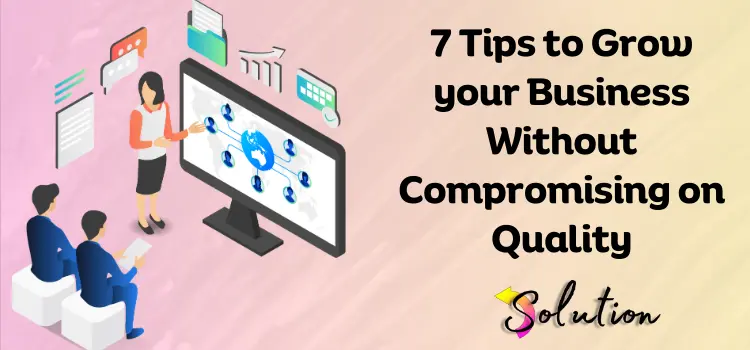
Nowadays organizations frequently run at full speed, attempting to meet aggressive targets and remain ahead of the competition. While this persistent push promotes expansion, it can also have unforeseen repercussions, most notably the lack of quality. Many business owners are so focused on quick development that they neglect the need of maintaining high standards in their products or services.
Unfortunately, poor quality may swiftly erode customer trust, harm brand reputation, and cause costly setbacks that endanger long-term success. So, how can you grow your business without sacrificing quality? The solution is to use smart tactics and tried-and-true techniques to ensure that development and quality coexist.
This blog contains actionable thoughts and guidance from seasoned company executives on how to achieve sustainable growth while maintaining the integrity of your products. Whether you want to simplify processes, maximize resources, or create an exceptional culture, this book will help your organization succeed without sacrificing quality. Continue reading to understand how to develop sensibly and strategically while maintaining client satisfaction and brand strength.
7 Effective Tips for Scaling Your Business without Losing Quality
Maintaining corporate growth requires a precise plan. When you know how to accomplish success, it becomes easy for you to sustain the growth graph. Challenges along the way are normal; the important thing is to figure out how to simply overcome them and get to your desired destination. You may easily accomplish this if you have a mental technique in place that allows you to maintain focus on certain tasks that may become distracting.
To assist you in creating your strategy notes, we have outlined a few basic steps that must be included in your business growth strategy.
Wrote down your goals: Making a strategy is one step toward achieving achievement. Scaling sales might entail acquiring new consumers or raising the average number of existing customers. Developing a good company strategy entails a systematic approach to analyzing your market, objectives, and competitive environment.
- Define clear objectives: This requires you to set SMART goals. Additionally, the company’s broader mission and vision should align with the objectives.
- Understand the market: The second step is to assess industry trends, client preferences, and upcoming prospects. Identify major client segments and customize your strategy to meet their demands. You may also utilize techniques such as SWOT analysis.
Must invest in technology: Don’t be afraid to use technology; there are many manual chores that can be automated, freeing up time for team members to focus on larger corporate goals and strategies. However, make sure to utilize the right technology to enhance the customer experience and foster innovation. Here are several technologies that every organization should examine.
- Cloud computing: Facilitates scalability and flexibility. In addition, it helps to reduce the expenses associated with on-premise IT infrastructure. Cloud computing enhances cooperation with solutions like Google Workspace and Microsoft 365. Amazon Web Services (AWS), Microsoft Azure, and Google Cloud are some of the most widely used cloud computing products.
- Customer relationship management system: The second point to notice is that creating customer relationships aids in the administration of customer interactions, sales funnels, and customer data. Additionally, it improves client retention and relationship management. Salesforce, Zoho CRM, and HubSpot are some essential applications that we recommend to you.
Analyze customer experience: Constantly monitoring customer experience is critical for business success since it has a direct influence on customer happiness, loyalty, and overall company performance. Look at the following few crucial points:
- Builds brand loyalty and advocacy: If you believe that examining customer experience is less significant than other aspects, then read on. Customers that have consistently good experiences become committed advocates, and they will begin to share their favorable feedback with others. Additionally, word-of-mouth recommendations and personal experience evaluations may significantly improve your brand’s image.
- Increase Revenue: Satisfied consumers are more inclined to spend more and return for future transactions. PWC discovered that 86% of shoppers are prepared to spend more for a positive customer experience.
Create a Budget Plan: Knowing what and how much you want to spend can make things easier for you. Having a comprehensive budget plan allows you to stay focused on what is important in your business while also removing the clutter. As a result, it will help you manage the tools and drive you to spend in your growth strategy based on actual demands.
- Promotes improved decision-making: A budget provides resources to key areas that are aligned with corporate objectives. It will encourage smart expenditures in growth areas like marketing, talent acquisition, and R&D. Improves informed decision-making on where to decrease expenses or boost investment in order to optimize ROI.
- Ensuring financial stability: The second advantage of budgeting is tracking income and spending. Ensuring that firms operate within their means. Preventing overspending preserves cash flow and lowers the likelihood of financial catastrophes.
Hire workers according to your needs: Hiring workers in numbers that do not correspond to the company requirements, whether too many or too few. This will have a huge influence on corporate growth. The following insights will help you understand how and why recruiting based on needs is essential:
- • Enhances operational efficiency: Proper staffing guarantees the equitable distribution of tasks, leading to a rise in output. The personnel are neither idle nor overwhelmed, allowing for a more efficient workflow. Hiring as needed helps minimize costs by avoiding costly solutions due to understaffing or wasteful spending due to overstaffing.
- Improving staff morale: A balanced workflow guarantees that the company can efficiently scale operations to satisfy both present and future expansion needs. Employees value and support proper staff organization fees, which increases engagement and retention.
Completely organize your accounts: Accounts must be clearly organized in order for a firm to flourish and provide financial transparency. It also improves decision-making and compliance. Here’s a more extensive look at how it may contribute to corporate success.
- Enhances financial clarity: It will offer an accurate picture of income, spending, assets, and obligations. It also enables business owners to assess their financial situation at any moment. Helps to enhance decision-making and find cost-cutting or investment opportunities.
- Improved cash flow management: Organized accounts keep track of receivables, payables, and cash flow trends. It guarantees prompt payment to suppliers and efficient collection from customers. As well as its approach not only mitigates the risk of cash shortages but also ensures operational stability.
Develop knowledge among employees: Employee knowledge development and improvement are critical for corporate growth. A competent staff promotes productivity, creativity, and customer happiness, which all contribute to company success. Here’s how employee knowledge development helps businesses grow:
- Improve productivity and efficiency: Employees who have received proper training can do duties more quickly and accurately. You’ll see perks like reducing mistakes and saving both time and resources. Additionally, it improves operational efficiency and production.
- Adapts to Industry Changes: Continuous learning allows staff to adapt to technical advances and market developments. This will help the organization remain nimble and resilient in challenging circumstances. It aids in preserving the organization’s relevance and competitiveness.
Common Mistakes to Avoid While Pursuing Business Growth
As a business owner, pursuing development is both exhilarating and hard. However, it is simple to slip into frequent pitfalls that might damage long-term performance. Recognizing these blunders early on will help you negotiate the complexity of expansion while also ensuring that your firm stays sustainable and profitable.
Ignoring market research: The worst error is growing without considering market demand, competition, or client preferences. This will result in the launch of products or services that do not resonate with the intended audience, as well as a waste of resources.
Neglecting customer experience: Putting expansion ahead of customer happiness, resulting in inadequate service or missed expectations. The effects will include losing loyal consumers and tarnishing your brand’s reputation.
Mismanaged finances: include inadequate planning, overinvestment in nonessential areas, and underestimating costs. It promotes cash flow issues and difficulties in maintaining expansion. It will result in decreased production, low morale, and high turnover rates.
Ignoring competition: This is a frequent but significant error that can stymie business progress. Competitor analysis sheds light on market dynamics, client preferences, and potential for differentiation.
Disregarding long-term vision: Set explicit, quantifiable objectives for where you want the organization to go in three, five, or even ten years. These goals should be consistent with your overarching mission and beliefs. Prioritize innovation and constant improvement in order to stay ahead of industry trends. This guarantees that your products or services develop to meet changing customer requirements.
Read Also:- Future-Proof Your Business with These Strategies
End note!
Scaling your business without sacrificing quality necessitates a planned approach that prioritizes maintaining high standards while growing. To meet rising demand, prioritize investments in efficient systems, automation, and personnel training. Create clear communication and a strong business culture to maintain consistency throughout all activities. Regularly analyze performance to discover opportunities for improvement, and do not sacrifice customer experience. By striking a balance between expansion and quality, you can guarantee that your company not only grows effectively but also maintains its reputation for excellence, creating long-term customer loyalty and sustainable success.


